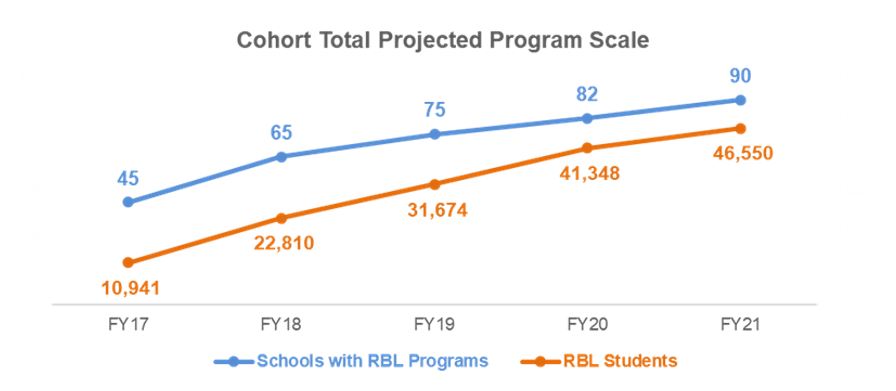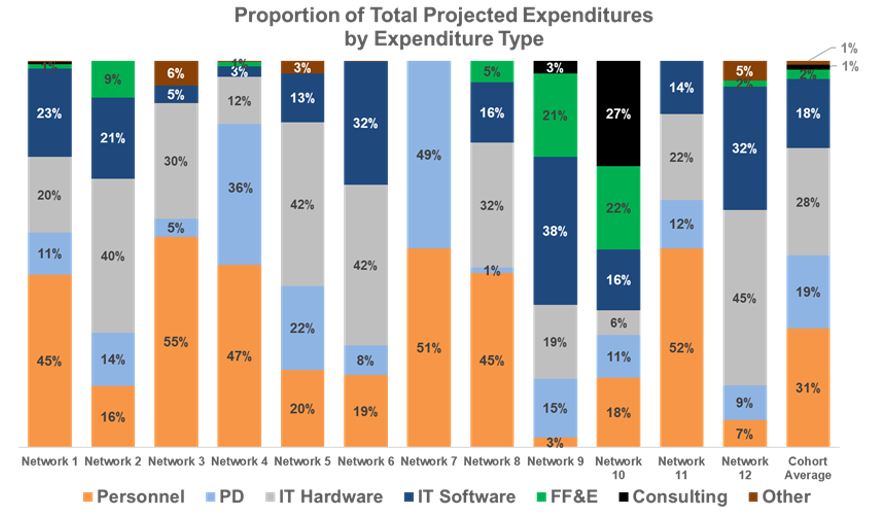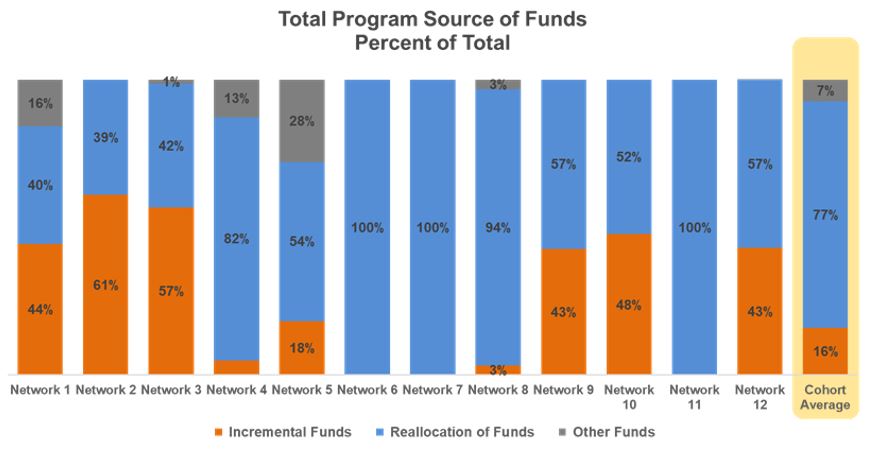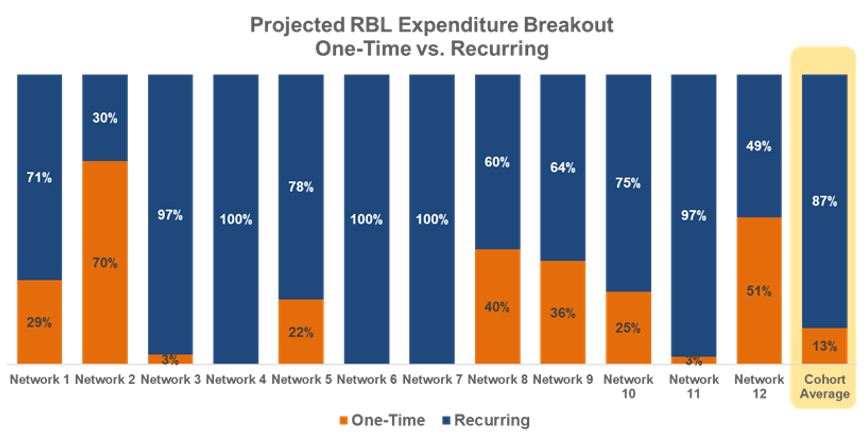This is the third installment of Afton’s blog series, “Lessons Learned from the Raising Blended Learners Initiative in Texas,” where we share our experiences, findings, and thought evolution over the course of the RBL initiative.
A detailed analysis of sources and uses of funds for the first year of the Raising Blended Learners grant program reveals:
- Sites plan to spend $209 per pupil on average, per year, over a five-year time period to support their blended learning models.
- While incremental funding will be used at some sites, most networks are planning to fund this initiative by reallocating existing expenditures to support blended learning in the long-term.
- Sites are incurring one-time costs to support their blended learning programs, but they plan to primarily invest in key design elements with recurring costs.
- Half of planned expenditures are investments in personnel and professional development, rather than software, hardware or other IT expenses.
- The expenditures and revenues detailed in this analysis exclude $6.4M spent on technical assistance providers used to support implementation through professional development services to RBL sites.
As school districts, charter school networks, and even single schools adopt new, innovative academic models, it’s important that leadership teams develop thoughtful plans to ensure that the initiative is implemented in a financially and operationally sustainable way. At Afton, we have found that while districts and charter networks may budget at the school level, they do not always identify the key design elements of their innovative models within their budgets and internal financial projections. Understanding the costs associated with an innovative model’s key design elements and identifying the sources of funding for these investments can help protect the initiative from future budget cuts and increase the likelihood that original goals for program size and scale within the network are met.
In Part 1 of this blog series, we note that one of the most useful exercises during the early stages of implementation planning involves developing an operationally-focused, multi-year financial plan for the pilot and ensuring data tracking processes are in place to track actual investments as compared to plan. In practice, this combination allows for more accurate long-term financial planning and more effective strategic resource management as pilots grow and evolve.
Over the past two years, Afton has worked with most of the Districts and Networks included in the Raising Blended Learners initiative in some capacity as providers of financial technical assistance. This RBL cohort includes a diverse set of organizations scaling a variety of different academic models. To help accurately capture sources and uses of funds across these sites, Afton developed a common data structure and data collection process, which was then used to assess, analyze, and compare different approaches to implementing blended learning programs at both the school and district/network level. Collecting a uniform, quantitative financial projection data set for each site supports not only prompted sites to take a methodical approach to planning, but this also enables more accurate financial analyses such as actual vs. projected expenditures, and plan changes over time.
Two years into the initiative, twelve sites (five demonstration sites and seven pilot network sites) continued to be highly engaged in financial sustainability work. While Afton provided varying levels of guidance and technical assistance throughout the plan development process depending on each site’s needs, the leadership teams at participating school districts and charter networks ultimately owned the data and assumptions included in their five-year financial plans. These figures have been captured in a database used to produce the analysis included below. All data captured and analyzed herein includes only the twelve sites that have provided final financial plans.
The plans submitted by school design teams and finance personnel at these RBL sites include detail on projected sources and uses of funds for the 2016-2017 school year (FY17) through the 2020-2021 school year (FY21). Over the next five years, RBL sites are taking different approaches and are planning to invest in different areas to support the effective scale of innovative programs at their networks. Below is a graphical summary of some major takeaways for this RBL cohort.
1) Scale At this time of this analysis, RBL sites had planned to scale from 45 to 90 schools (2x) and from 10,941 to 46,550 students (4.3x) from FY17 to FY21.

2) Level of Investment The size of investment (in total and on a per pupil basis) varies widely among all sites: from $90 to over $900 per pupil, and from $200K to $10.5M in total, over the five-year period analyzed. These investments include both incremental funding and re-purposing of existing funds. See point 5 below for more information on Sources of Funds.

3) Investment Trend and Efficiencies As the RBL initiative scales at all sites, the cost per pupil to implement blended learning declines from $423 in year 1 to $167 in year 5. This is primarily driven by one-time start-up costs in early years, and efficiencies realized as the initiative scales and resources are reallocated.

4) Common Investments Over the five year time period, sites plan to spend about half of RBL funds on Personnel and Professional Development to support their blended learning programs, with IT Hardware as the next highest investment area.

5) Sources of Funds Funding for these investments is supported primarily with reallocation of recurring general fund dollars and re-purposing of existing positions.

6) One-time vs. Recurring Investments Sites are planning to primarily spend on recurring investments, with some spend planned for one-time investments, mostly in the early years of the pilot.

For the twelve sites included in the analysis above, most are on-track to sustain innovation – both during the grant period and beyond – though risks exist for each. In addition to the cohort-wide analysis, Afton developed a financial sustainability rubric to assess the current and projected financial health of each site. The rubrics include detailed information on: a) current financial health, b) capital planning, c) financial policies and procedures, d) the multi-year financial plan, and e) the pilot budget and variance analysis. We anticipate sharing some of the outcomes of the sustainability rubric in future blog posts.
While the codified multi-year financial projections lend insight into the different strategic resource management approaches that districts and networks are using, they do not tell the full story. In our forthcoming posts, we explore some anecdotal examples and case studies from our work supporting individual RBL sites.
Check out the other posts from our blog series, Lessons Learned from the Raising Blended Learners Initiative in Texas:
- RBL Part 1 – Finance and Innovation: the role of finance in the early stages of academic innovation
- RBL Part 2 – Working Together: supporting grant applicant teams through the application process